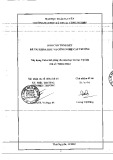
Vietnam Journal of Mathematics 33:1 (2005) 85–89
9LHWQDP -RXUQDO
RI
0$7+(0$7,&6
9$67
Some Results on Mid-Point Sets
of Sets of Natural Numbers
D. K. Ganguly1, Rumki Bhattacharjee1, and Maitreyee Dasgupta2
1Department of Pure Mathematics, University of Calcutta,
35, Ballygunge Circular Road, Kolkata 700 019, India
2WIB(M) 3/2, Phase II, Golf Green, Kolkata 700 095, India
Received February 4, 2004
Abstract. In this paper the authors study some properties of the mid-point sets
of sets of natural numbers using upper (lower) asymptotic density of sets of natural
numbers. In this connection a set has been introduced here and studied.
1. Introduction
Let Pand Qbe two linear sets of points. The mid-point set M(P, Q) has been
defined as the set M(P, Q)=x+y
2:x∈P, y ∈Q.Inparticular,for
P=Q,wewriteM(P, P)=M(P). Again whenever Aand Bare two linear
sets of points with positive abscissae then their ratio set R(A, B) is defined as
R(A, B)={(a/b):a∈A, b ∈B}. In particular, when A=B,wewrite
R(A, A)=R(A). With the usual notations Nis the set of natural numbers and
R+is the set of positive rational numbers.
One may recall here the notion of asymptotic density of a set of positive
integers which is extensively used by ˘
Salat [5] in studying some properties of
ratio sets of sets of natural numbers. Later, other authors viz Bukor, Kmetova
and Toth [2] worked on ratio sets of sets of natural numbers.
Let A⊂N,A =∅then A(n) denotes the counting function of Agiven by
A(n)=
a∈A, a≤n
1. The lower asymptotic density of Ais given by lim inf
n→∞
A(n)
n=
d(A) and the upper asymptotic density is given by lim sup
n→∞
A(n)
n=d(A). If

86 D. K. Ganguly, Rumki Bhattacharjee, and Maitreyee Dasgupta
d(A)=d(A) we call the common value d(A) as the asymptotic density of A.
On the other hand, mid-point sets, primarily of Cantor type sets were studied
by Randolph [4] and subsequently by Bose Majumdar [1]. Then Ganguly and
Majumdar [3] proved some results on mid-point sets of two linear sets in the
light of the Lebesgue density. In the present paper the authors restrict their
investigations into mid-point sets of sets of natural numbers with the help of the
notion of asymptotic density.
2. Main Results
We shall study some properties of A⊂Nwhich guarantee the denseness of M(A)
in [1,∞).
Theorem 2.1. Let d(A)=1where A⊂N. Then each positive rational number
can be represented as the mid-point for infinite number of pairs (g, h),g∈A,
h∈A.
Proof. Assuming the theorem not to be true there must exist an r(∈R+)=
(p/q)=1,(p, q) = 1 such that r=g+h
2only for a finite number of pairs
(g, h),g ∈A, h ∈A.Let (gi,h
i),i=1,2, ..., m, be all the pairs of numbers
of Asatisfying the relation r=gi+hi
2,i=1,2, ..., m. Let us denote max
(g1,g
2, ..., gm,h
1,h
2, ..., hm)byaand form the sequence
a, a +1, ..., n (n>a).(1)
The numbers in the sequence (1) are characterized by the fact that the mid-
pointofanytwoofthemisdifferentfromr. Now, to sequence (1) belong all the
numbers p+uwhere
a<p+u≤ni.e. a−p<u≤n−p. (α)
and also the numbers q−vwhere
a<q−v≤ni.e. a−q<−v≤n−q. (β)
Next we put s=max(p, q)ands=min(p, q). Then relation (α)leadsto
a−s<u≤n−sand (β) yields a−s<−v≤n−s. Combining these two
inequalities we can state that the numbers p+i, q −ibelong to sequence (1) if
a−s<|i|≤n−s.(2)
Again from the fact that the mid-point of any two numbers of Abelonging
to sequence (1) is different from r, we can assert that at least one of p+iand
q−idoes not belong to Aif |i|satisfies condition (2). Now, we denote by T1(T2)
the set of |i|which satisfies (2) but for which p+i∈ A(q−i∈ A)istrue.
Also, let P(Tj),j =1,2 denote the number of elements of the set Tj.Then
P(T1)+P(T2)≥(n−s)−(a−s) and consequently at least one of the numbers
P(T1)andP(T2) is not smaller than (1/2)[(n−s)−(a−s)].

Some Results on Mid-Point Sets of Sets of Natural Numbers 87
Therefore by the definition of T1and T2and also recalling A(n)=
a∈A,a≤n
1
we arrive at the inequality A(n)≤n−(1/2)((n−s)−(a−s)). Therefore
d(A) = lim sup
n→∞
A(n)
n≤1−(1/2) <1 which contradicts the assumption and
hence the result follows.
Corollary. If d(A)=1then M(A)=R+.
Note. The converse of this theorem is not necessarily true. For example, the
set A={2,3,4,6,7,8,10,11,12, ...}has upper density 1/2 but M(A)isdensein
R+.
We now propose to study some sufficient conditions for the set M(A)notto
be nowhere dense in the interval [1,∞). For this end we first prove the following
theorem.
Theorem 2.2. Let the set A⊂Nbe such that for each a, b on the real line
with 1<a<bwe have lim inf
n→∞
A((2b−1)n)
A((2a−1)n)>1. Then there exists an interval
I⊂(1,∞), such that I∩M(A)=∅.
Proof. Since A⊂N, we can certainly take Ato be an infinite set. It serves
our purpose to prove that the intersection of the set M(A)withanintervalis
non-empty.
From the given condition of the theorem it can be stated that there exists a
natural number n0such that
A((2b−1)n)
A((2a−1)n)>1forn>n
0.
Abeing an infinite set we can find a q∈Asuch that q>n
0and for this q
the inequality A((2b−1)q)−A((2a−1)q)>0 holds true. Then there exists a
number p∈Asuch that
(2a−1)q<p≤(2b−1)q⇒a<p+q
2≤bq
i.e. the intersection of the set M(A) with the interval (a, bq)wherebq > b is
non-empty. In other words the set M(A) is not nowhere dense in [1,∞).
Theorem 2.3. If the set A⊂Nhas a positive asymptotic density then the
mid-point set M(A)is not nowhere dense in [1,∞).
Proof. By definition the asymptotic density of Ais given by d(A) = lim
n→∞
A(n)
n
and we have d(A)>0 by assumption. For simplicity we write dfor d(A).
Applying the result of the foregoing theorem it needs only to show that for
each a, b on the positive half of the real axis with 1 <a<bthe inequality
lim inf
n→∞
A((2b−1)n)
A((2a−1)n)>1istrue.
Let us choose an ε(>0) so that

88 D. K. Ganguly, Rumki Bhattacharjee, and Maitreyee Dasgupta
(1) ε< d(b−a)
a+b−1.Sinced= lim
n→∞
A(n)
nthere exists an x0>0 such that
(2) (d−ε)x<A(x)<(d+ε)xfor x>x
0.Next we choose a natural number n0
such that (2a−1)n>x
0for n>n
0which obviously leads to (2b−1)n>x
0for
n>n
0.Then using (2) we get
(3) A((2b−1)n)
A((2a−1)n)>(d−ε)(2b−1)n
(d+ε)(2a−1)n=(d−ε)(2b−1)
(d+ε)(2a−1) for n>n
0and for
pre-assigned ε>0.
Now from (1) ε(a+b−1) <d(b−a)⇒ε(2a+2b−2) <d(2b−2a) i.e.
(d+ε)(2a−1) <(d−ε)(2b−1) ⇒(d−ε)(2b−1)
(d+ε)(2a−1) >1. Thus by (3) we must
have A((2b−1)n)
A((2a−1)n)>1forn>n
0.It follows that lim inf
n→∞
A((2b−1)n)
A((2a−1)n)>1,
1<a<band hence the result by Theorem 2.2.
Theorem 2.4. Let A be a subset of natural numbers with positive upper asymp-
totic density.
Then the set M(A)given by M(A)=c∈N:c=a+b
2,a∈A, b ∈Ahas
also positive upper asymptotic density.
Proof. By the given condition d(A)>0 i.e. lim sup
n→∞
A(n)
n>0whereA(n)=
a∈A,a<n
1. Then a positive integer n0canbesochosenthat(A(n))/n > 0for
n>n
0⇒A(n)>0forn>n
0.In other words for a∈A,b∈Awhere a≤n,
b≤nso that c=a+b
2≤nwe have
(1) A(n)=Σ1>0forn>n
0. Hence writing Min place of M(A) for conve-
nience we get M(n)=
c∈M,c≤n
1forn>n
0by virtue of (1). Hence M(n)
n>0
for n>n
0leading to lim sup
n→∞
M(n)
n>0 i.e. d(M(A)) >0isproved.
Theorem 2.5. Let A⊂Nsatisfy the condition lim inf
n→∞
A((2b−1)n)
A((2a−1)n)>1for
any pair of real numbers a, b where 1<a<b. Then the set M1(A)defined as
M1(A)=x∈[0,∞):∃{pn}∈A, {qn}∈Asuch that x= lim
n→∞
pn+qn
2n
is dense in [0,∞)provided lim
n→∞
qn
nor lim
n→∞
pn
n=l(la finite quantity different
from x).
Proof. It serves our purpose to show that the set M1(A) has non-empty inter-
section with the interval (al, bl).
We can take Ato be an infinite set. Then a natural number n0can certainly
be found so that A((2b−1)n)
A((2a−1)n)>1forn>n
0and also we can find sufficiently

Some Results on Mid-Point Sets of Sets of Natural Numbers 89
large qn(>n
0)∈Asuch that the inequality A((2b−1)qn)>A((2a−1)qn)holds
true for n>n
0.Then there exists pn∈Asuch that
(2a−1)qn<p
n<(2b−1)qnfor n>n
0or aqn
n<pn+qn
2n<b
qn
n.
Taking limit as n→∞we get al ≤lim
n→∞
pn+qn
2n≤bl i.e. al ≤x≤bl
which indicates that the intersection of the set M1(A) with the interval (al, bl)
is non-empty. In other words the set M1(A) is dense in the interval [0,∞).
References
1. N. C. Bose Majumdar, On the distance set of the Cantor middle third set, III,
Amer. Math. Monthly 72 (1965) 725.
2. J. Bukor, M. Kmetova, and J. Toth, Notes on ratio sets of sets of natural numbers,
Acta Math. (Nitra)2(1995) 35–40.
3. D. K.Ganguly and M. Majumdar, Some results on mid-point sets, J. Pure Math.
7(1990) 27–33.
4. J. Randolph, Distances between points of the Cantor Set, Amer. Math. Monthly
47 (1940) 549–551.
5. T. Salat, On the ratio sets of sets of natural numbers, Acta Arithmetica 15 (1969)
273–278.






![Báo cáo seminar chuyên ngành Công nghệ hóa học và thực phẩm [Mới nhất]](https://cdn.tailieu.vn/images/document/thumbnail/2025/20250711/hienkelvinzoi@gmail.com/135x160/47051752458701.jpg)









